 1
1 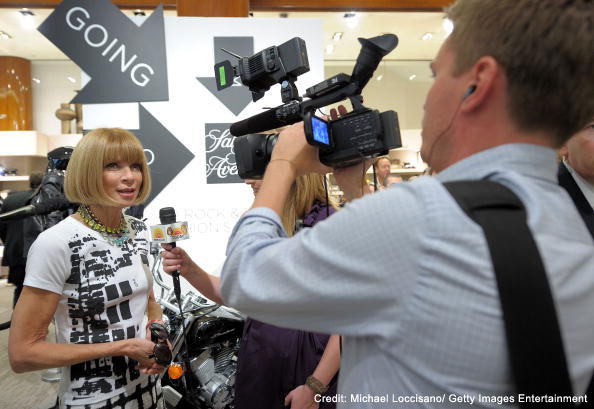
As Fashion’s Night Out (FNO) is finally being put to rest, I’ve taken the time to reflect on Anna Wintour’s power. Specifically, whether or not she’s “too big to fail” and if she’s smart enough to navigate any disaster that may come her way.
It’s no secret to those who know me that I have a love/hate relationship with the snappish lady who put fashion to bed with politics. I don’t recall when I first became aware of her power, but it’s been an enlightening experience to see her move mountains and (probably) buy herself an ambassadorship position in the process. While I am still working on figuring out her superpowers, I am sharing with you the lessons I’ve learned from her FNO fiasco.
Let’s start from the beginning.
Remember 2009? Between the economy crumbling and Bernie Madoff’s Ponzi scheme, the most affluent felt less than optimistic about their futures and, consequently, stopped spending. The fashion industry was caught with their pants down and excess inventory, which lead to panic and erratically slashed prices. Anna Wintour knew how to capitalize on the nervous frenzy.
What you should take from this experience: TIMES OF CRISIS ARE THE BEST TIMES TO CONSOLIDATE POWER. Don’t be afraid of a crisis. Regardless of the later outcome, you will get people to pay attention to you in that moment.
I don’t want to imply that from the very beginning FNO was just a plot to further Anna Wintour’s career. However, let’s not forget that after coming up with the FNO initiative and being perceived as saving the fashion world from crumbling, Condé Nast gave Anna Wintour another five year contract.
Lesson to be learned: MOST PEOPLE GET PERSONAL GAINS WHILE THEY LOOK LIKE THEY ARE SAVING THE WORLD.
Now, to me the FNO plan looked doomed from the beginning. I am going to quote Gawker here because I couldn’t say it better:
“The plan seems to spend a lot of money getting people in the stores to spend a lot of money. The one thing we haven’t heard anything about is discounts. Just because Catherine Malandrino is converting her Meatpacking showplace into a French cafe for the evening doesn’t mean that suddenly more people will be able to afford one of her cocktail dresses.”
The lesson: WHEN PEOPLE THINK YOU ARE AN EXPERT, THERE IS NO LIMIT TO WHAT YOU CAN SELL, REGARDLESS OF HOW CRAZY IT IS.
After four years — which seemed to drain rather than fill the fashion industry’s coffins — FNO has finally been put to rest. Anna has not personally spoken on th topic yet, and I doubt she will.
When Steven Kolb, chief executive officer of the Council of Fashion Designers of America (CFDA), was asked about the money brought in by FNO, this is what he had to say:
“I don’t think the success of it was measured only by numbers or money, but was really about engagement. Everyone feels we had a great four years.”
What is the lesson to be learned here? REGARDLESS OF HOW BAD A SITUATION IS, IT IS RARELY A 100% FAILURE. FOCUS ON THE POSITIVE AND MAKE THE WHOLE THING LOOK LIKE A SUCCESS.
By Mirela Gluck
Posted by Mirela Gluck at 08:00 AM
Insights , Opinions , Points of View , The City |
 0
0 
While I tend to shop alone, there’s something particularly delightful about a retail date with a girlfriend (or several). In fact, I find that some of my best shopping is done when I’m with another person who keeps me fiscally responsible and realistic in terms of what flatters me and what looked better on the mannequin. I often rely on that second opinion and, even without the presence of shopping buddy, send snapshots to girlfriends (or the husband) to get their opinion.
In addition to giving candid fashion advice, though, shopping with girlfriends can be therapeutic. If you’re anything like me, shopping is a very personal process. As women, we’re naturally body-conscious (perhaps even more so in the presence of other females). Additionally, our individual style choices are a reflection of our innermost selves. Sharing the whole clothes-shopping experience with another person requires you to open up and get personal. For that reason, shopping can be a genuine bonding experience.
Another therapeutic benefit of shopping with your girlfriends: it’s not always about the clothes or accessories. Use the retail excursion as an opportunity to gab about whatever is on your mind. Vent office frustrations, share the week’s accomplishments, dish on your romantic life, etc. Be a good listener/empathizer/
Do’s and Don’ts of Shopping with Girlfriends
Do: Plan ahead. Talk about what stores you want to hit, what’s on your shopping list and how much you’re willing to spend. This makes it much easier to hold each other accountable.
Don’t: Invite the whole gang. An intimate group will make for a more meaningful (and simpler) shopping experience. One to three shopping buddies is plenty.
Do: Be sensitive to your friends’ budgets and fashion preferences. Choose a location with a diverse range of high/low end stores and be open to shopping at all of them.
Don’t: Hog the mirror. If your friend is admiring her own reflection, give her the space and then use it when she’s finished.
Do: Always lead with the positive. If the garment doesn’t look that great on your girlfriend, be sensitive about it. For example, “That collar is so flattering to your neckline. I wonder how the top would look with this skirt instead of the jeans.”
Don’t: Gossip about mutual friends. You shouldn’t do this in any situation. Doing so makes others wonder if you talk about them when they aren’t around and they’re less likely to open up.
By Wendy Rose Gould
Posted by Wendy Rose Gould at 08:00 AM
Opinions , Saving Tips , SHOPPING |
 0
0 As a Phoenix desert resident, my “spring cleaning” generally takes place somewhere between summer’s 115 degree temperatures and winter’s rainy monsoon season. However, when I lived in the great Midwest, that distinct turn from winter weather to sunny spring always inspired me to open the windows, air the place out and get to cleaning.
I imagine those of you in New York are gearing up for that much desired weather about-face. As you prepare to usher in chirping robins and skinny squirrels who’ve reluctantly crawled out of their cozy hibernations, start thinking about your own spring cleaning. And, more specifically, organizing your wardrobe.
Below I’ve briefly outlined what to do with garments you no longer want to keep. Let the list inspire you to get rid of things, if not for more closet space than for a little extra dough in your back pocket.

1. Store it
Let’s face it. Going through your closet isn’t a black and white process. You have a “keep pile,” a “toss pile” and a “Eh… I’m not really sure what I want to do with this yet” pile. The lattermost is the trickiest. After all, the last thing you want to do is regret your decision to toss something out. Anything with sentimental value, for example, should be kept. Designate a box for “maybes,” label it as such and then thoughtfully re-visit the clothes again on another day.

2. Sell It
As someone who frequently moves, my favorite part of spring cleaning is getting rid of things (fewer things to pack up later). What makes it even more fun, though, is cashing it all in. I’ve become quite good at this and, honestly, could write a whole book on the process. I’ll give you a few highlights and tips below, though.
– Sell it online via online via eBay or Craigslist. Craigslist is fee free, but it will require more of your time and the ability to coordinate your schedule with buyers’ schedules. High end items in good condition do best. I prefer eBay because it’s less work.
– If it’s vintage (especially high end), consider selling it on Etsy. Especially if you have a lot of it. You’ll have to pay seller fees, but the Etsy platform attracts thousands of buyers willing to spend money on high quality. Always take attractive pictures and detail blemishes, dimensions and any pertinent information.
– Head to a local consignment shop. This requires the least amount of your time and you won’t get the whole profit, but at least you still make money on your goods. Always call ahead to see what the shop needs most and bring your garments clean and on hangers.

3. Give It Away
There will always be a few garments that others don’t want. For example, clothing that shows its age or has tears, stains or pilling are not going to sell. Consignment shops will simply reject them and online buyers won’t bite. For these, let’s call them “unwantables,” your best bet is to simply donate.
You have several options. First, you can offer them for free on websites such as Craigslist and Freecycle. This is nice because anyone who claims them will come to you.
Alternatively, you can donate them to local homeless shelters or thrift stores. Donating to a registered charity allows you to claim tax deductions. Always ask the organization for a proper form.
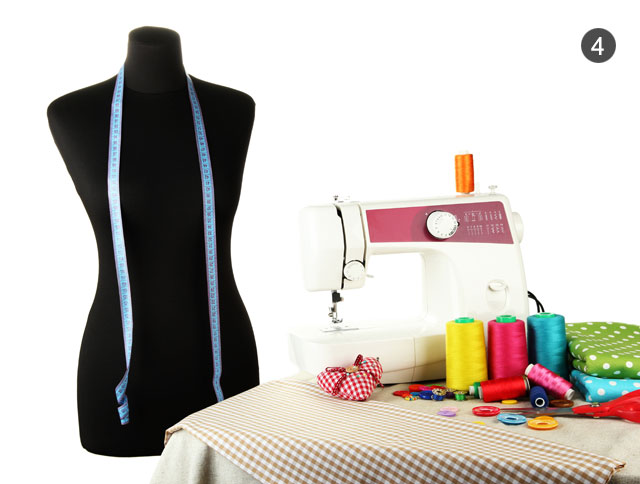
4. DIY it
If you’re crafty (or want to be crafty), thoughtfully examine any “unwantables” and re-invent them. For example, old frocks with pretty patterns can easily be turned into throw pillows or re-cover an old chair. Check YouTube or Pinterest for thousands of ideas.
You can also upcycle an old garment by adding to it or changing it in some way. Again, lots of ideas are available online. The below blogs are some of my favorite DIY Fashion blogs — let them inspire your own creations!
By Wendy Rose Gould
Posted by Wendy Rose Gould at 09:00 AM
Opinions , Points of View , Shopping News , Shopping Trends , The City , Tips Guides |
 0
0 When you think about fashion’s past, the runways seemed to have a great influence over what became regular occurrence in popular culture. Today, however, roles have been reversed. Instead of fashion influencing the public, many times it seems as though the public — and what the public will pay for — is what influences fashion.
Unlike 30, 20 or even 10 years ago, today we have we have myriad celebrities designing their own lines and reality TV shows making a giant splash in the style scene. And with the Internet greatly decreasing magazine sales and creating more competition for designers (it seems that nearly every one with an inkling for clothing design can now put their work out there for the masses to see and buy), more and more magazine editors and fashion designers are preoccupied with creating a product that’s easy to sell, as opposed to a product that’s purely innovative
Kristin Chenoweth, Lisa Rinna and Brooke Burke wearing the Women’s Ottoman Pencil Dress from Kardashian Kollection.

Credit: KhloeKardashian.Celebuzz.com
We would be unimpressed with art that was driven only to please the eye. True art lovers want to be inspired, influenced and even changed by what they see. A beautiful picture of a flower has its purpose, but flower after pretty flower gets boring very fast.
Fashion is like art. It should strive to provoke and evoke. It should dare to go there and not merely be manufactured for the sake of a quick and easy paycheck.
The History of Fashion Design entry on Wikipedia says, “For many of the own-label designers who emerged in the early years of the 21st century, financial factors became increasingly critical. Many new young talents found they now depended on investors (to whom, in extreme cases, they would even surrender their names) and were always burdened by the risk that their partners, motivated by market realism and the desire for quick returns, would severely restrict their autonomy.”
If this continues, do we risk having a “blip” in the fashion timeline — a period when fashion is uninspiring to future generations? What are your thoughts? How do you think today’s fashion will be remembered in the years to come?
Fall 2011 – 60s Vibe!


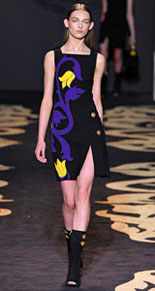
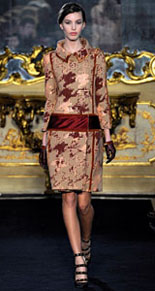
Credit: Style.com
70’s/Boho Trend
Spring 2008 Ready-to-Wear

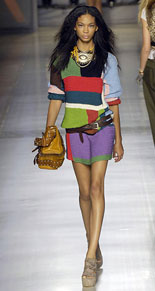
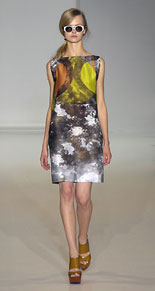

Credit: Style.com
By Wendy Rose Gould
Posted by Wendy Rose Gould at 11:18 AM
bargain news , Fashion: Trends, Style, and Business , Insights , Opinions , Style , Trends , Trends |
